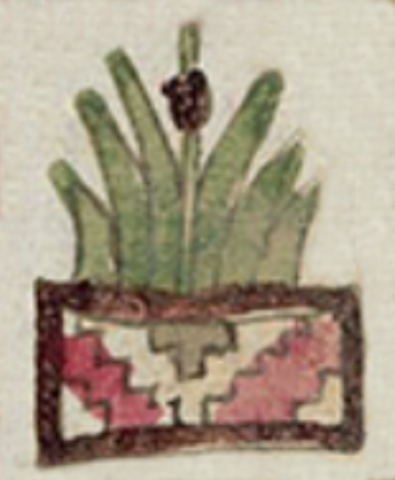Mexico (CST34)
This painting of the compound glyph for the place name Mexico regularly appears in the Codex Sierra when referencing Mexico City. It is the “ñucoyo glyph,” a Mixtec glyph that refers to Mexico City. This representation of the capital of New Spain shows a rectangle with a stepped fret design, alternating between red and brown. Coming up out of the top of this patterned rectangle is a group of six reeds (tolin) that includes one cattail in the center.
Stephanie Wood
Kevin Terraciano points out how the Mixtec name for Mexico City is Ñucoyo, “place of reeds,” which invokes Tollan (Tula), a place name that involves tule reeds and, therefore, the Toltec heritage claimed by the Mexica. For more on the Codex Sierra, see Kevin Terraciano’s study (2021), especially pp. 19 and 20. Just as an aside, it might be worth exploring whether the rectangle with the stepped frets, which are so well known in carvings on Mixtec and Zapotec temples and in Zapotec rugs, have an association with artificial hills (pyramids, called tlachihualtepetl, in Nahuatl, or mogotes in Oaxaca). The tule reeds also have a strong association with wetlands, including lakeshores, and therefore water (atl). Thus, this sign for Mexico City, might be akin to the Nahua altepetl (water-hill) sign. Cholulan associations may also be relevant. See the Relación Geográfica detail showing the tlachihualtepetl with tule reeds.
Stephanie Wood
1550–1564
Jeff Haskett-Wood
topónimos, Ciudad de México, capital city, tules, construcción, arquitectura, construcción, tules, escalonadas, escalonas, pirámides, toltequidad, toltecayotl, nombres de lugares

Mexico, the altepetl of the Mexica, also known as Mexico-Tenochtitlan, former imperial capital, https://nahuatl.wired-humanities.org/content/Mexico
México
Stephanie Wood
Códice Sierra-Texupan, plate 34, page dated 1560. Origin: Santa Catalina Texupan, Mixteca Alta, State of Oaxaca. Kevin Terraciano has published an outstanding study of this manuscript (Codex Sierra, 2021), and in his book he refers to alphabetic and “pictorial” writing, not hieroglyphic writing. We are still counting some of the imagery from this source as hieroglyphic writing, but we are also including examples of “iconography” where the images verge on European style illustrations or scenes showing activities. We have this iconography category so that such images can be fruitfully compared with hieroglyphs. Hieroglyphic writing was evolving as a result of the influence of European illustrations, and even alphabetic writing impacted it.
https://bidilaf.buap.mx/objeto.xql?id=48281&busqueda=Texupan&action=search
The Biblioteca Digital Lafragua of the Biblioteca Histórica José María Lafragua in Puebla, Mexico, publishes this Códice Sierra-Texupan, 1550–1564 (62pp., 30.7 x 21.8 cm.), referring to it as being in the “Public Domain.” This image is published here under a Creative Commons license, asking that you cite the Biblioteca Digital Lafragua and this Visual Lexicon of Aztec Hieroglyphs.






